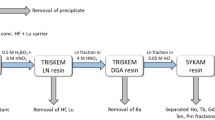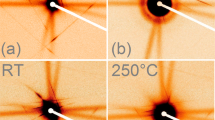Abstract
An energetic ion slowing down in an insulating crystal produces radiation damage which can be preferentially etched, making what is called a track1. Such nuclear tracks have numerous applications in many disciplines, including cosmochemistry and astrophysics1. Fleischer et al.2, for example, identified cosmic ray nuclei heavier than Fe by means of fossil tracks recorded in meteoritic crystals. Attempts to use tracks in meteorites to study the chemical composition of ultraheavy cosmic rays, however, have led to ambiguous results (see ref. 3). One possible reason for this lack of success has been the absence of calibrations for ions heavier than krypton, because no particle accelerator could accelerate them to sufficiently high energies. This barrier has been removed by the recent acceleration, at the Bevalac of the Lawrence Berkeley Laboratory, of uranium ions to relativistic energies4–6. The results on tracks of 238U ions of 190 MeV per nucleon in olivine that we now report, are the first of this kind obtained with a mineral nuclear track detector. They show that the etchable part of a U ion trail is surprisingly long (nearly 3 mm). These results have an important bearing both on the interpretation of cosmic-ray tracks in lunar and meteoritic crystals, and on models of track formation in minerals.
This is a preview of subscription content, access via your institution
Access options
Subscribe to this journal
Receive 51 print issues and online access
$199.00 per year
only $3.90 per issue
Buy this article
- Purchase on Springer Link
- Instant access to full article PDF
Prices may be subject to local taxes which are calculated during checkout
Similar content being viewed by others
References
Fleischer, R. L., Price, P. B. & Walker, R. M. Nuclear Tracks in Solids (University of California Press, 1975).
Fleischer, R. L., Price, P. B., Walker, R. L., Maurette, M. & Morgan, G. J. geophys. Res. 72, 355–366 (1967).
Otgonsuren, O. et al. Astrophys. J. 210, 258–266 (1976).
Alonso, J. R. et al. Science 217, 1135–1137 (1982).
Heckman, H. H., Karant, Y. J. & Friedlander, E. M. Science 217, 1137–1138 (1982).
Ahlen, S. P., Tarle, G. & Price, P. B. Science 217, 1139–1140 (1982).
Lal, D., Rajan, R. S. & Tamhane, A. S. Nature 221, 33–37 (1969).
Barkas, W. H. & Berger, M. J. Tables of Energy Losses and Ranges of Heavy Charged Particles (NASA SP-3013, 1964).
Storzer, D., Poupeau, G. & Kratschmer, W. Geochim. cosmochim. Acta Suppl. 4 3, 2363–2377 (1973).
Price, P. B., Lal, D., Tamhane, A. S. & Perelygin, V. P. Earth planet. Sci. Lett. 19, 377–395 (1973).
Krishnaswami, S., Lal, D., Prabhu, N. & Tamhane, A. S. Science 174, 287–291 (1971).
Perron, C. & Pellas, P. 18th int. Cosmic Ray Conf., Bangalore Pap. OG 1–24 (Tata Institute of Fundamental Research, Bombay, 1983).
Pellas, P. & Perron, C. Nucl. Instrum. Meth. Phys. Res. B1, 387–393 (1984).
Dartyge, E., Duraud, J. P., Langevin, Y. & Maurette, M. Phys. Rev. B23, 5213–5229 (1981).
Author information
Authors and Affiliations
Rights and permissions
About this article
Cite this article
Perron, C. Relativistic 238U ion tracks in olivine and cosmic-ray track studies. Nature 310, 397–399 (1984). https://doi.org/10.1038/310397a0
Received:
Accepted:
Issue Date:
DOI: https://doi.org/10.1038/310397a0
Comments
By submitting a comment you agree to abide by our Terms and Community Guidelines. If you find something abusive or that does not comply with our terms or guidelines please flag it as inappropriate.



